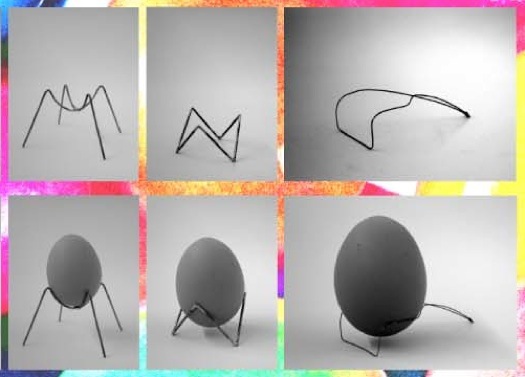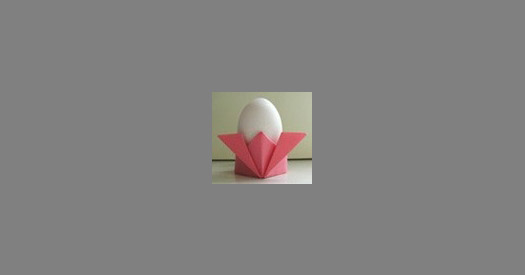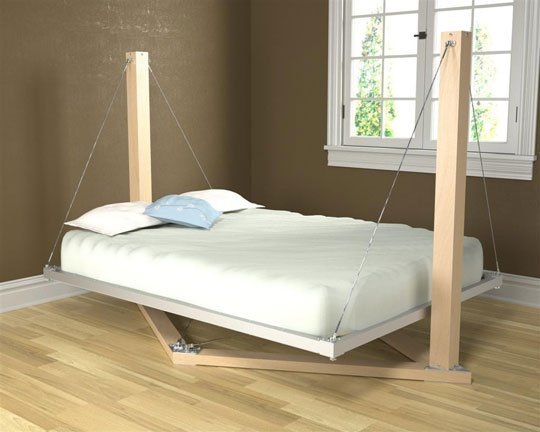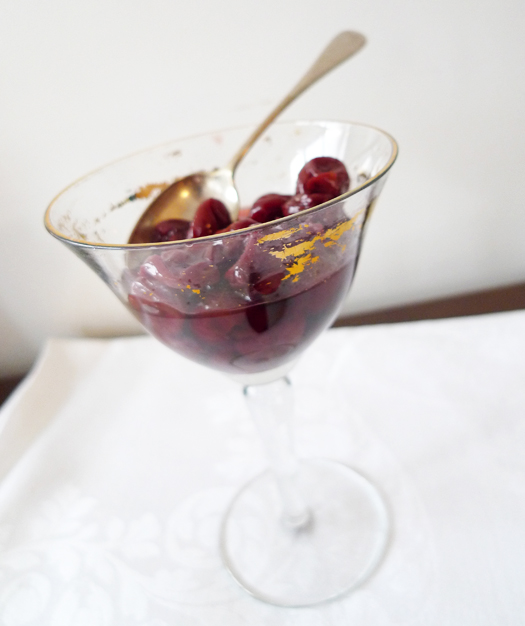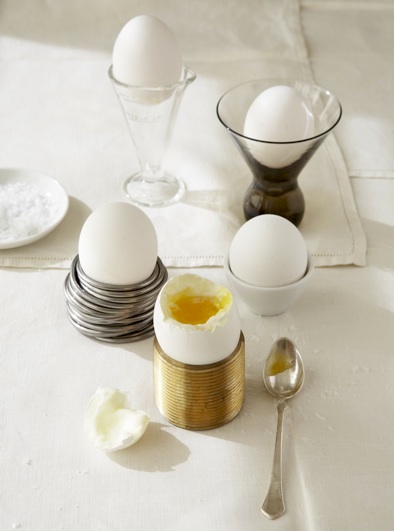
Hardware stores and art supply stores are great places to inspire your improvisational leanings, using a variation of the children’s game “inventing”: think of uses for things you may not be familiar with.
The other day, as I was browsing through bins of bolts, screws, hunks of pipe and gaskets in my local hardware store, I suddenly flashed on “egg cups!” as I played with a rather moderne-looking 2-inch length of threaded brass pipe. The idea of improvising an egg cup using found stuff became a lens through which I scanned the store. It turns out that egg cups are everywhere, just waiting to be discovered by lovers of perfect soft-boiled eggs (see recipe below).
In an art supply store, I came across a coil of thick, easily-bendable armature wire which, when pulled apart slightly, became a wonderful sculptural, asymmetrical holder for an egg. (You can also use soldering wire from a hardware store but beware that it may have lead in it: don’t let it come in contact with the edible part of the egg.) Stretched out longer and carefully balanced, the wire becomes a kinetic sculpture.
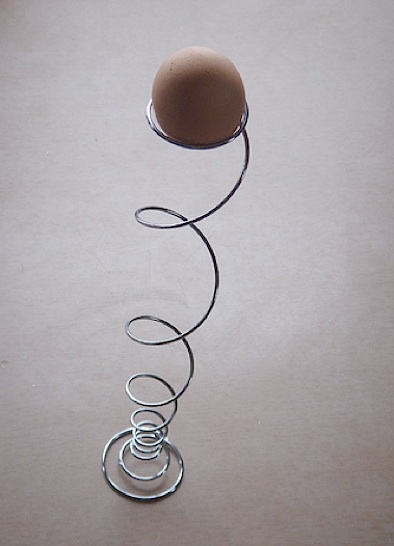
Short lengths of ordinary 1 1/2-inch-diameter copper pipe make charming egg cups when polished to a high sheen. Back home, I searched my kitchen cabinets for other egg cup candidates; a 50’s cocktail glass, a teeny French ramekin and a miniature laboratory beaker work wonderfully. When foraging for egg cups, figure an inside dimension of about 1 1/2 to 1 5/8-inches in diameter.
When I told a friend about my improvisations, he said: “I wonder when the first egg cup was made.” That lead to the discovery that egg cups were found in the ruins of Pompeii in 79 A.D., and that there is a vast virtual world of egg cups: of histories, collections, art installations, clubs and numerous websites. The wonderfully quirky blog Egg Cups has loads of great resources, like this architectural project for egg cups done at Cologne’s Faculty of Architecture…
…and some improvised egg cups made with a bottle cap, toilet paper tubes, and wet tissues. My favorite is this origami egg cup:
Recipe: Soft-Boiled Eggs with Toast Soldiers
This is the best way to cook a real, truly fresh egg if you’re lucky enough to get hold of some and want to experience the pure flavor of egg. I recommend accompanying the eggs with toast soldiers, buttered toast that is sliced into 1-inch rectangles for dipping into the yolk. The next best thing is popcorn.
Making a perfect soft-boiled egg, with a firm-but-tender white and runny yolk, is one of those cooking processes that eludes absolute consistency and perfection every time. Since eggs are a really sensitive substance, differences in temperature, altitude and egg size can throw calculations off a bit. If you follow this method, however, you’ll have a high record of success. Once you’ve done it one or two times, you’ll figure out the perfect timing to achieve the consistency of egg you like.
You can do this with as many eggs as you can fit roomily, in one layer, in the bottom of a saucepan, though more than 4 eggs may require slightly longer cooking time.
Put the eggs in a bowl of hot tap water for about 5 minutes to warm them. Use this time for slicing bread for toast soldiers and getting the other elements ready, such as butter and a knife for spreading it, as you’ll want to need to move quickly once the eggs start cooking.
Fill a saucepan with enough water to cover the eggs by about one inch and bring to a boil.
(Depending on how long your toaster takes, you may want to start your bread toasting once the water is boiling. It will need to be ready to butter when the eggs are almost done.)
Set a timer for 4 minutes. Using a slotted spoon, carefully lower the eggs into the water as you turn the flame down to a simmer or very low boil. Start the timer. (Do not allow the water to boil as it toughens the white and jostles the eggs so they crack).
When the eggs are done, remove them from the water with a slotted spoon and run cold tap water briefly over them to stop the cooking. Blot each egg with a tea towel as you place it point-side-up in an egg cup. You’ll have about 30 to 40 seconds once the eggs are in their cups before they’ll start to overcook. Butter and the toast soldiers if you haven’t already. Arrange some around each egg and serve at once.
To eat a soft-boiled egg, use a dinner knife to cut off the top 1/2 inch of shell. Add sea salt and pepper to taste and eat with a teaspoon.

